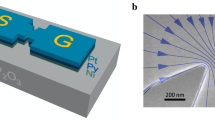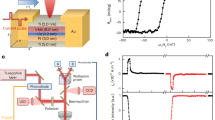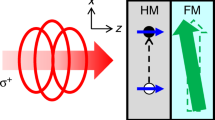Abstract
The efficient detection of a magnetic state at nanoscale dimensions is important for the development of spin-logic devices. Magnetoresistance effects can be used to detect magnetic states, but they do not generate an electromotive force (that is, a voltage) or a current that can be used to drive a circuit element for logic device applications. Here we report a favourable scaling law for the detection of an in-plane magnetic state of a magnet by using the inverse spin Hall effect in cobalt–iron/platinum (CoFe/Pt) nanostructured devices. By reducing the dimensions of the device, we obtain a large spin Hall signal of 0.3 Ω at room temperature and quantify an effective spin-to-charge conversion rate for the ferromagnetic/heavy metal system. We predict that this spin–orbit detection of magnetic states could be used to drive spin-logic circuits.
This is a preview of subscription content, access via your institution
Access options
Access Nature and 54 other Nature Portfolio journals
Get Nature+, our best-value online-access subscription
$29.99 / 30 days
cancel any time
Subscribe to this journal
Receive 12 digital issues and online access to articles
$119.00 per year
only $9.92 per issue
Buy this article
- Purchase on Springer Link
- Instant access to full article PDF
Prices may be subject to local taxes which are calculated during checkout



Similar content being viewed by others
Data availability
The data that support the plots within this paper and other findings of this study are available from the corresponding authors on reasonable request.
References
Moore, G. E. Cramming more components onto integrated circuits. Proc. IEEE 86, 82–85 (1998).
Auth, C. et al. A 10nm high performance and low-power CMOS technology featuring 3rd generation FinFET transistors, Self-Aligned Quad Patterning, contact over active gate and cobalt local interconnects. In 2017 IEEE International Electron Devices Meeting 29.1.1–29.1.4 (IEEE, 2017); https://doi.org/10.1109/IEDM.2017.8268472
Dennard, R. H., Gaensslen, F. H., Rideout, V. L., Bassous, E. & LeBlanc, A. R. Design of ion-implanted MOSFET’s with very small physical dimensions. IEEE J. Solid-State Circuits 9, 256–268 (1974).
Manipatruni, S. et al. Scalable energy-efficient magnetoelectric spin–orbit logic. Nature 565, 35–42 (2019).
Dery, H., Dalal, P. & Sham, L. J. Spin-based logic in semiconductors for reconfigurable large-scale circuits. Nature 447, 573–576 (2007).
Behin-Aein, B., Datta, D., Salahuddin, S. & Datta, S. Proposal for an all-spin logic device with built-in memory. Nat. Nanotechnol. 5, 266–270 (2010).
Koo, H. C. et al. Control of spin precession in a spin-injected field effect transistor. Science 325, 1515–1518 (2009).
Thomson, W. XIX. On the electro-dynamic qualities of metals: effects of magnetization on the electric conductivity of nickel and of iron. Proc. R. Soc. Lond. 8, 546–550 (1857).
Binasch, G., Grünberg, P., Saurenbach, F. & Zinn, W. Enhanced magnetoresistance in layered magnetic structures with antiferromagnetic interlayer exchange. Phys. Rev. B 39, 4828–4830 (1989).
Baibich, M. N. et al. Giant magnetoresistance of (001) Fe/(001) Cr magnetic superlattices. Phys. Rev. Lett. 61, 2472–2475 (1988).
Jin, S., McCormack, M., Tiefel, T. H. & Ramesh., R. Colossal magnetoresistance in La–Ca–Mn–O ferromagnetic thin films. J. Appl. Phys. 76, 6929–6933 (1994).
Julliere, M. Tunneling between ferromagnetic films. Phys. Lett. A 54, 225–226 (1975).
Wang, W. & Victora, R. H. Enhancement of giant magnetoresistance and oscillation by wave-vector filtering in Fe/Ag/Fe/InAs/Ag. Phys. Rev. B 94, 245415 (2016).
Takemura, R. et al. Highly-scalable disruptive reading scheme for Gb-scale SPRAM and beyond. In 2010 IEEE International Memory Workshop 1–2 (IEEE, 2010); https://doi.org/10.1109/IMW.2010.5488324
Manipatruni, S., Nikonov, D. E. & Young, I. A. Beyond CMOS computing with spin and polarization. Nat. Phys. 14, 338–343 (2018).
Kato, Y. K., Myers, R. C., Gossard, A. C. & Awschalom, D. D. Observation of the spin Hall effect in semiconductors. Science 306, 1910–1913 (2004).
Sinova, J. et al. Spin Hall effects. Rev. Mod. Phys. 87, 1213–1259 (2015).
Soumyanarayanan, A., Reyren, N., Fert, A. & Panagopoulos, C. Emergent phenomena induced by spin–orbit coupling at surfaces and interfaces. Nature 539, 509–517 (2016).
Mellnik, A. R. et al. Spin-transfer torque generated by a topological insulator. Nature 511, 449–451 (2014).
Rojas-Sánchez, J.-C. et al. Spin to charge conversion at room temperature by spin pumping into a new type of topological insulator: α-Sn films. Phys. Rev. Let. 116, 096602 (2016).
Chappert, C., Fert, A. & Nguyen Van Dau, F. The emergence of spin electronics in data storage. Nat. Mater. 6, 813–823 (2007).
Miron, I. M. et al. Current-driven spin torque induced by the Rashba effect in a ferromagnetic metal layer. Nat. Mater. 9, 230–234 (2010).
Liu, L. et al. Spin-torque switching with the giant spin Hall effect of tantalum. Science 336, 555–558 (2012).
Laczkowski, P. et al. Large enhancement of the spin Hall effect in Au by side-jump scattering on Ta impurities. Phys. Rev. B 96, 140405(R) (2017).
Pham, V. T. et al. Ferromagnetic/nonmagnetic nanostructures for the electrical measurement of the spin Hall effect. Nano Lett. 16, 6755–6760 (2016).
Sagasta, E. et al. Tuning the spin Hall effect of Pt from the moderately dirty to the superclean regime. Phys. Rev. B 94, 060412(R) (2016).
Liu, L., Chen, C.-T. & Sun, J. Z. Spin Hall effect tunnelling spectroscopy. Nat. Phys. 10, 561–566 (2014).
Yan, W. et al. Large room temperature spin-to-charge conversion signals in a few-layer graphene/Pt lateral heterostructure. Nat. Commun. 8, 661 (2017).
Nguyen, M.-H., Ralph, D. C. & Buhrman, R. A. Spin torque study of the spin Hall conductivity and spin diffusion length in platinum thin films with varying resistivity. Phys. Rev. Lett. 116, 126601 (2015).
Zahnd, G. et al. Spin diffusion length and polarization of ferromagnetic metals measured by the spin-absorption technique in lateral spin valves. Phys. Rev. B 98, 174414 (2018).
Wang, L. et al. Giant room temperature interface spin Hall and inverse spin Hall effects. Phys. Rev. Lett. 116, 196602 (2016).
Li, S., Shen, K. & Xia, K. Interfacial spin Hall effect and spin swapping in Fe|Au bilayer from first principles. Phys. Rev. B 99, 134427 (2019).
Nagaosa, N., Sinova, J., Onoda, S., MacDonald, A. H. & Ong, N. P. Anomalous Hall effect. Rev. Mod. Phys. 82, 1539–1592 (2010).
Bauer, G. E. W., Saitoh, E. & Van Wees, B. J. Spin caloritronics. Nat. Mater. 11, 391–399 (2012).
Sagasta, E. et al. Unveiling the mechanisms of the spin Hall effect in Ta. Phys. Rev. B 98, 060410(R) (2018).
Sayed, S., Hong, S. & Datta, S. Transmission-line model for materials with spin-momentum locking. Phys. Rev. Appl. 10, 054044 (2018).
Garello, K. et al. Symmetry and magnitude of spin–orbit torques in ferromagnetic heterostructures. Nat. Nanotechnol. 8, 587–593 (2013).
Safeer, C. K. et al. Room temperature spin Hall effect in graphene/MoS2 van der Waals heterostructures. Nano Lett. 19, 1074–1082 (2019).
Lesne, E. et al. Highly efficient and tunable spin-to-charge conversion through Rashba coupling at oxide interfaces. Nat. Mater. 15, 1261–1266 (2016).
Acknowledgements
We acknowledge R. Llopis and R. Gay for technical assistance with the sample fabrication and thank S. Sayed and S. Datta for fruitful discussions on the transmission line model and the equivalent circuit. V.T.P. thanks L. Vila for fruitful discussions on the local spin detection/injection technique. This work is supported by Intel Corporation through the Semiconductor Research Corporation under MSR-INTEL TASK 2017-IN-2744 and the ‘FEINMAN’ Intel Science Technology Center, and by the Spanish MINECO under the Maria de Maeztu Units of Excellence Programme (MDM-2016-0618) and under project numbers MAT2015-65159-R and RTI2018-094861-B-100. V.T.P. and W.Y.C. acknowledge postdoctoral fellowship support from ‘Juan de la Cierva—Formación’ programme by the Spanish MINECO (grant numbers FJCI-2017-34494 and FJC2018-038580-I, respectively). E.S. thanks the Spanish MECD for a PhD fellowship (grant number FPU14/03102).
Author information
Authors and Affiliations
Contributions
V.T.P. and F.C. conceived the study. V.T.P. and I.G. performed the experiments, with the help of W.Y.C. V.T.P., I.G., S.M., W.Y.C., D.E.N., E.S., C.-C.L., T.G., I.Y., S.M., L.E.H. and F.C. analysed the data and discussed the experiments. V.T.P. derived the equations from the 1D spin diffusion model. V.T.P. and A.M. performed the 3D FEM simulation based on the spin diffusion model. V.T.P., S.M. and F.C. wrote the manuscript. All the authors contributed to the scientific discussion and manuscript revision. F.C. supervised the work.
Corresponding authors
Ethics declarations
Competing interests
The authors declare no competing interests.
Additional information
Publisher’s note Springer Nature remains neutral with regard to jurisdictional claims in published maps and institutional affiliations.
Supplementary information
Supplementary Information
Supplementary Notes 1–9, Figs. 1–9 and Table 1.
Source data
Source Data Fig. 1
Excel file contains the source data of Fig. 1.
Source Data Fig. 2
Excel file contains the source data of Fig. 2.
Source Data Fig. 3
Excel file contains the source data of Fig. 3.
Rights and permissions
About this article
Cite this article
Pham, V.T., Groen, I., Manipatruni, S. et al. Spin–orbit magnetic state readout in scaled ferromagnetic/heavy metal nanostructures. Nat Electron 3, 309–315 (2020). https://doi.org/10.1038/s41928-020-0395-y
Received:
Accepted:
Published:
Issue Date:
DOI: https://doi.org/10.1038/s41928-020-0395-y
This article is cited by
-
Inverse chirality-induced spin selectivity effect in chiral assemblies of π-conjugated polymers
Nature Materials (2024)
-
Interfacial magnetic spin Hall effect in van der Waals Fe3GeTe2/MoTe2 heterostructure
Nature Communications (2024)
-
Voltage-based magnetization switching and reading in magnetoelectric spin-orbit nanodevices
Nature Communications (2024)
-
Rashba-like physics in condensed matter
Nature Reviews Physics (2022)
-
Gate-tuneable and chirality-dependent charge-to-spin conversion in tellurium nanowires
Nature Materials (2022)



